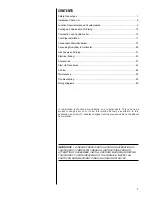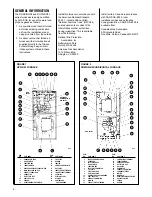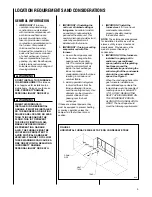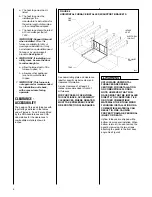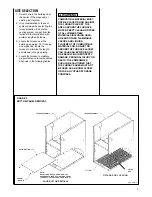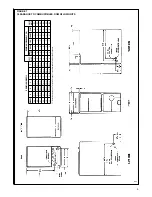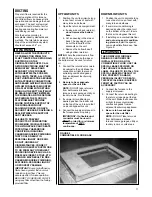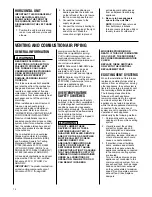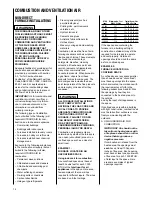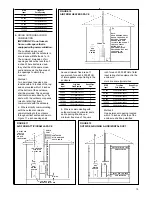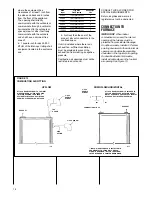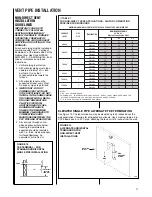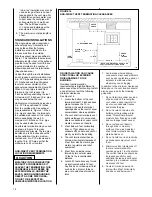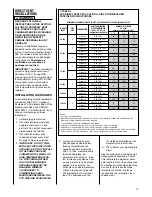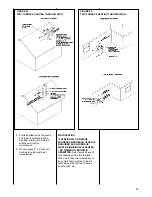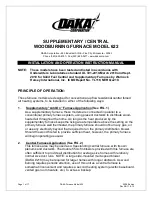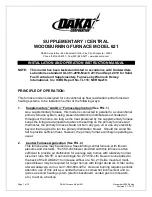
12
GENERAL INFORMATION
READ AND FOLLOW ALL IN-
STRUCTIONS IN THIS SECTION.
FAILURE TO PROPERLY VENT
THIS FURNACE CAN CAUSE
CARBON MONOXIDE POISONING
OR AN EXPLOSION OR FIRE,
RESULTING IN PROPERTY
DAMAGE, PERSONAL INJURY
OR DEATH.
This furnace removes both sensible
and latent heat from the combustion
flue gases. Removal of latent heat
results in condensation of flue gas
water vapor. This condensed water
vapor drains from the secondary heat
exchanger and out of the unit into a
drain trap.
When installed as a non-direct vent
furnace, only exhaust piping is
required and inside combustion air
may be used. Refer to section on
“COMBUSTION & VENTILATION AIR
FOR FURNACE INSTALLATIONS.”
Direct vent installations require a
dedicated combustion air and venting
system. All air for combustion is taken
from the outside atmosphere and all
combustion products are discharged
to the outdoors.
The combustion air and vent pipe
fittings must conform to American
National Standards Institute (ANSI)
and American Society for Testing
Materials (ASTM) standards
D1785 (Schedule 40 PVC), D2665
(PVC-DWV), D2241 (SDR-21 and
SDR26-26 PVC), D2661 (ABS-DWV)
or F628 (Schedule 40 ABS-DWV).
In Canada all combustion air and vent
pipe must be CSA- or ULC-certified
Schedule 40 PVC, PVC-DWV or
ABS-DWV.
IMPORTANT: The plastic combustion
air and venting components are of
Schedule 40 PVC. If using ABS
piping, ensure that the solvent
cement is compatible for joining
PVC to ABS components or use a
mechanical connection that can
withstand the vent temperatures and
are corrosion resistant.
NOTE: Schedule 40 ABS-DWV pipe
and fittings may be used as an
alternate to PVC pipe for the
combustion air inlet and vent pipes.
NOTE: Cellular core PVC is also
approved for use. It must be schedule
40PVC-DWV cellular pipe for non-
pressure applications and
manufactured under ASTM F-891.
OVERTEMPERATURE
SAFETY SWITCHES
Furnaces are equipped with safety
switches in the control compartment
to protect against overtemperature
conditions caused by inadequate
combustion air supply. The switches
for the upflow and downflow models
are located in the burner
compartment. If a switch is tripped it
must be manually reset.
DO NOT JUMPER THESE
DEVICES! IF ONE OF THESE
SWITCHES SHOULD TRIP, A
QUALIFIED INSTALLER, SERVICE
AGENCY OR THE GAS SUPPLIER
MUST BE CALLED TO CHECK
AND/OR CORRECT FOR
ADEQUATE COMBUSTION AIR
SUPPLY. DO NOT RESET THE
SWITCHES WITHOUT TAKING
CORRECTIVE ACTION TO ASSURE
THAT AN ADEQUATE SUPPLY OF
COMBUSTION AIR IS MAINTAINED
UNDER ALL CONDITIONS OF
OPERATION. FAILURE TO DO SO
CAN RESULT IN CARBON
MONOXIDE POISONING OR
DEATH. IF THIS UNIT IS MOUNTED
IN A CLOSET, THE DOOR MUST
BE CLOSED WHEN MAKING THIS
CHECK.
REPLACE THESE SWITCHES
ONLY WITH THE IDENTICAL
REPLACEMENT PART.
EXISTING VENT SYSTEMS
When the installation of this furnace
replaces an existing furnace that is
removed from a vent system serving
other appliances, the vent system is
likely to be too large to properly vent
the remaining attached appliances.
The following steps should be
followed with each appliance
remaining connected to the original
common vent system. Place the
appliance to be tested in operation,
while the other appliances remaining
connected to the common vent
system are not in operation. Test the
operation of each appliance
individually by the following method.
1. Permanently seal any unused
openings in the common venting
system.
2. Visually inspect the venting
system for proper size and
horizontal pitch and determine
that there is no blockage,
restriction, leakage, corrosion or
other deficiencies which could
cause an unsafe condition.
3. If practical, close all building
doors, windows and all doors
between the space where the
appliances remaining connected
to the common venting system
are located.
Turn on clothes dryers and any
appliance not connected to the
common venting system. Turn on
any exhaust fans, such as range
hoods and bathroom exhausts,
so they will operate at maximum
speed. Do not operate a summer
exhaust fan. Close fireplace
dampers.
VENTING AND COMBUSTION AIR PIPING
!
WARNING
!
WARNING
HORIZONTAL UNIT
IMPORTANT: THIS FURNACE MAY
ONLY BE INSTALLED SO AS
WHEN FACING THE FRONT OF
THE FURNACE, SUPPLY AIR IS
DISCHARGED ON THE LEFT HAND
SIDE.
1. Position the unit to minimize long
runs or runs with many turns and
elbows.
2. If summer air conditioning is
desired, position the indoor coil
on the left end of the unit. Insure
that no air can bypass this coil.
3. Connect the furnace to the
supply air plenum.
4. Connect the return air ducting to
the return air opening at the right
end of the unit. Make the
connection air tight to prevent
entraining combustion gases
from an adjacent fuel-burning
appliance.
5. Be sure to have adequate
space for the unit filter.
NOTE: DO NOT take return air
from bathrooms, kitchens,
furnace rooms, garages, utility or
laundry rooms, or cold areas.
Summary of Contents for RGRA SERIES
Page 62: ...62...
Page 63: ...63...
Page 64: ...64 Rheem Manufacturing Company Air Conditioning Division Fort Smith Arkansas CM 1197...



